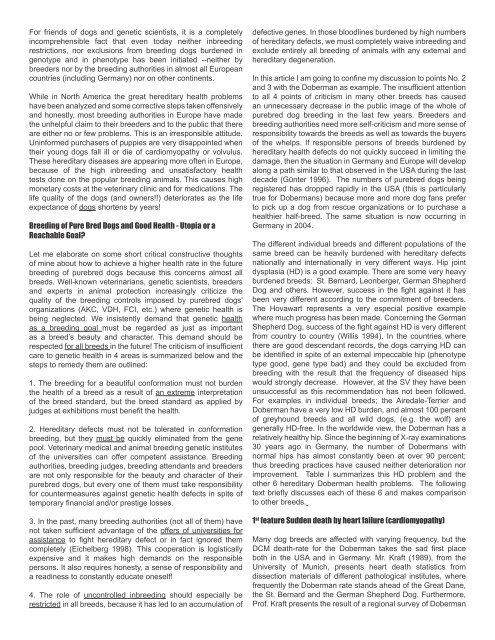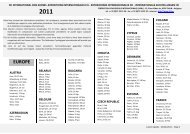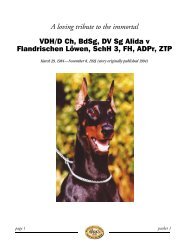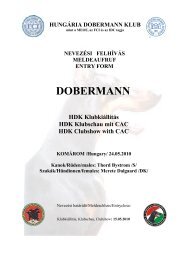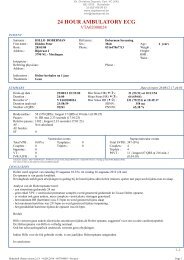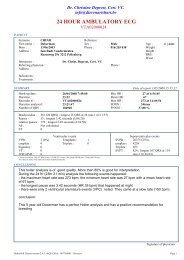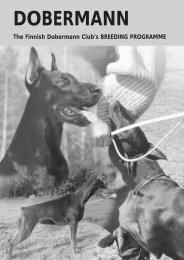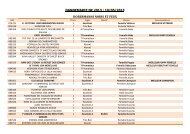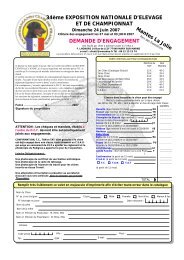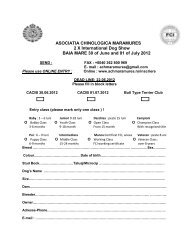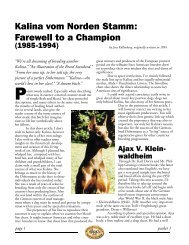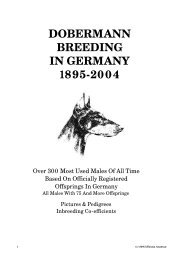Increasing Hereditary Health Problems in the Breeding of Purebred ...
Increasing Hereditary Health Problems in the Breeding of Purebred ...
Increasing Hereditary Health Problems in the Breeding of Purebred ...
- No tags were found...
You also want an ePaper? Increase the reach of your titles
YUMPU automatically turns print PDFs into web optimized ePapers that Google loves.
For friends <strong>of</strong> dogs and genetic scientists, it is a completely<strong>in</strong>comprehensible fact that even today nei<strong>the</strong>r <strong>in</strong>breed<strong>in</strong>grestrictions, nor exclusions from breed<strong>in</strong>g dogs burdened <strong>in</strong>genotype and <strong>in</strong> phenotype has been <strong>in</strong>itiated --nei<strong>the</strong>r bybreeders nor by <strong>the</strong> breed<strong>in</strong>g authorities <strong>in</strong> almost all Europeancountries (<strong>in</strong>clud<strong>in</strong>g Germany) nor on o<strong>the</strong>r cont<strong>in</strong>ents.While <strong>in</strong> North America <strong>the</strong> great hereditary health problemshave been analyzed and some corrective steps taken <strong>of</strong>fensivelyand honestly, most breed<strong>in</strong>g authorities <strong>in</strong> Europe have made<strong>the</strong> unhelpful claim to <strong>the</strong>ir breeders and to <strong>the</strong> public that <strong>the</strong>reare ei<strong>the</strong>r no or few problems. This is an irresponsible attitude.Un<strong>in</strong>formed purchasers <strong>of</strong> puppies are very disappo<strong>in</strong>ted when<strong>the</strong>ir young dogs fall ill or die <strong>of</strong> cardiomyopathy or volvulus.These hereditary diseases are appear<strong>in</strong>g more <strong>of</strong>ten <strong>in</strong> Europe,because <strong>of</strong> <strong>the</strong> high <strong>in</strong>breed<strong>in</strong>g and unsatisfactory healthtests done on <strong>the</strong> popular breed<strong>in</strong>g animals. This causes highmonetary costs at <strong>the</strong> veter<strong>in</strong>ary cl<strong>in</strong>ic and for medications. Thelife quality <strong>of</strong> <strong>the</strong> dogs (and owners!!) deteriorates as <strong>the</strong> lifeexpectance <strong>of</strong> dogs shortens by years!Breed<strong>in</strong>g <strong>of</strong> Pure Bred Dogs and Good <strong>Health</strong> - Utopia or aReachable Goal?Let me elaborate on some short critical constructive thoughts<strong>of</strong> m<strong>in</strong>e about how to achieve a higher health rate <strong>in</strong> <strong>the</strong> futurebreed<strong>in</strong>g <strong>of</strong> purebred dogs because this concerns almost allbreeds. Well-known veter<strong>in</strong>arians, genetic scientists, breedersand experts <strong>in</strong> animal protection <strong>in</strong>creas<strong>in</strong>gly criticize <strong>the</strong>quality <strong>of</strong> <strong>the</strong> breed<strong>in</strong>g controls imposed by purebred dogs’organizations (AKC, VDH, FCI, etc.) where genetic health isbe<strong>in</strong>g neglected. We <strong>in</strong>sistently demand that genetic healthas a breed<strong>in</strong>g goal must be regarded as just as importantas a breed’s beauty and character. This demand should berespected for all breeds <strong>in</strong> <strong>the</strong> future! The criticism <strong>of</strong> <strong>in</strong>sufficientcare to genetic health <strong>in</strong> 4 areas is summarized below and <strong>the</strong>steps to remedy <strong>the</strong>m are outl<strong>in</strong>ed:1. The breed<strong>in</strong>g for a beautiful conformation must not burden<strong>the</strong> health <strong>of</strong> a breed as a result <strong>of</strong> an extreme <strong>in</strong>terpretation<strong>of</strong> <strong>the</strong> breed standard, but <strong>the</strong> breed standard as applied byjudges at exhibitions must benefit <strong>the</strong> health.2. <strong>Hereditary</strong> defects must not be tolerated <strong>in</strong> conformationbreed<strong>in</strong>g, but <strong>the</strong>y must be quickly elim<strong>in</strong>ated from <strong>the</strong> genepool. Veter<strong>in</strong>ary medical and animal breed<strong>in</strong>g genetic <strong>in</strong>stitutes<strong>of</strong> <strong>the</strong> universities can <strong>of</strong>fer competent assistance. Breed<strong>in</strong>gauthorities, breed<strong>in</strong>g judges, breed<strong>in</strong>g attendants and breedersare not only responsible for <strong>the</strong> beauty and character <strong>of</strong> <strong>the</strong>irpurebred dogs, but every one <strong>of</strong> <strong>the</strong>m must take responsibilityfor countermeasures aga<strong>in</strong>st genetic health defects <strong>in</strong> spite <strong>of</strong>temporary f<strong>in</strong>ancial and/or prestige losses.3. In <strong>the</strong> past, many breed<strong>in</strong>g authorities (not all <strong>of</strong> <strong>the</strong>m) havenot taken sufficient advantage <strong>of</strong> <strong>the</strong> <strong>of</strong>fers <strong>of</strong> universities forassistance to fight hereditary defect or <strong>in</strong> fact ignored <strong>the</strong>mcompletely (Eichelberg 1998). This cooperation is logisticallyexpensive and it makes high demands on <strong>the</strong> responsiblepersons. It also requires honesty, a sense <strong>of</strong> responsibility anda read<strong>in</strong>ess to constantly educate oneself!4. The role <strong>of</strong> uncontrolled <strong>in</strong>breed<strong>in</strong>g should especially berestricted <strong>in</strong> all breeds, because it has led to an accumulation <strong>of</strong>defective genes. In those bloodl<strong>in</strong>es burdened by high numbers<strong>of</strong> hereditary defects, we must completely waive <strong>in</strong>breed<strong>in</strong>g andexclude entirely all breed<strong>in</strong>g <strong>of</strong> animals with any external andhereditary degeneration.In this article I am go<strong>in</strong>g to conf<strong>in</strong>e my discussion to po<strong>in</strong>ts No. 2and 3 with <strong>the</strong> Doberman as example. The <strong>in</strong>sufficient attentionto all 4 po<strong>in</strong>ts <strong>of</strong> criticism <strong>in</strong> many o<strong>the</strong>r breeds has causedan unnecessary decrease <strong>in</strong> <strong>the</strong> public image <strong>of</strong> <strong>the</strong> whole <strong>of</strong>purebred dog breed<strong>in</strong>g <strong>in</strong> <strong>the</strong> last few years. Breeders andbreed<strong>in</strong>g authorities need more self-criticism and more sense <strong>of</strong>responsibility towards <strong>the</strong> breeds as well as towards <strong>the</strong> buyers<strong>of</strong> <strong>the</strong> whelps. If responsible persons <strong>of</strong> breeds burdened byhereditary health defects do not quickly succeed <strong>in</strong> limit<strong>in</strong>g <strong>the</strong>damage, <strong>the</strong>n <strong>the</strong> situation <strong>in</strong> Germany and Europe will developalong a path similar to that observed <strong>in</strong> <strong>the</strong> USA dur<strong>in</strong>g <strong>the</strong> lastdecade (Günter 1996). The numbers <strong>of</strong> purebred dogs be<strong>in</strong>gregistered has dropped rapidly <strong>in</strong> <strong>the</strong> USA (this is particularlytrue for Dobermans) because more and more dog fans preferto pick up a dog from rescue organizations or to purchase ahealthier half-breed. The same situation is now occurr<strong>in</strong>g <strong>in</strong>Germany <strong>in</strong> 2004.The different <strong>in</strong>dividual breeds and different populations <strong>of</strong> <strong>the</strong>same breed can be heavily burdened with hereditary defectsnationally and <strong>in</strong>ternationally <strong>in</strong> very different ways. Hip jo<strong>in</strong>tdysplasia (HD) is a good example. There are some very heavyburdened breeds: St. Bernard, Leonberger, German ShepherdDog and o<strong>the</strong>rs. However, success <strong>in</strong> <strong>the</strong> fight aga<strong>in</strong>st it hasbeen very different accord<strong>in</strong>g to <strong>the</strong> commitment <strong>of</strong> breeders.The Hovawart represents a very especial positive examplewhere much progress has been made. Concern<strong>in</strong>g <strong>the</strong> GermanShepherd Dog, success <strong>of</strong> <strong>the</strong> fight aga<strong>in</strong>st HD is very differentfrom country to country (Willis 1994). In <strong>the</strong> countries where<strong>the</strong>re are good descendant records, <strong>the</strong> dogs carry<strong>in</strong>g HD canbe identified <strong>in</strong> spite <strong>of</strong> an external impeccable hip (phenotypetype good, gene type bad) and <strong>the</strong>y could be excluded frombreed<strong>in</strong>g with <strong>the</strong> result that <strong>the</strong> frequency <strong>of</strong> diseased hipswould strongly decrease. However, at <strong>the</strong> SV <strong>the</strong>y have beenunsuccessful as this recommendation has not been followed.For examples <strong>in</strong> <strong>in</strong>dividual breeds; <strong>the</strong> Airedale-Terrier andDoberman have a very low HD burden, and almost 100 percent<strong>of</strong> greyhound breeds and all wild dogs, (e.g. <strong>the</strong> wolf) aregenerally HD-free. In <strong>the</strong> worldwide view, <strong>the</strong> Doberman has arelatively healthy hip. S<strong>in</strong>ce <strong>the</strong> beg<strong>in</strong>n<strong>in</strong>g <strong>of</strong> X-ray exam<strong>in</strong>ations30 years ago <strong>in</strong> Germany, <strong>the</strong> number <strong>of</strong> Dobermans withnormal hips has almost constantly been at over 90 percent;thus breed<strong>in</strong>g practices have caused nei<strong>the</strong>r deterioration norimprovement. Table I summarizes this HD problem and <strong>the</strong>o<strong>the</strong>r 6 hereditary Doberman health problems. The follow<strong>in</strong>gtext briefly discusses each <strong>of</strong> <strong>the</strong>se 6 and makes comparisonto o<strong>the</strong>r breeds.1 st feature Sudden death by heart failure (cardiomyopathy)Many dog breeds are affected with vary<strong>in</strong>g frequency, but <strong>the</strong>DCM death-rate for <strong>the</strong> Doberman takes <strong>the</strong> sad first placeboth <strong>in</strong> <strong>the</strong> USA and <strong>in</strong> Germany. Mr. Kraft (1989), from <strong>the</strong>University <strong>of</strong> Munich, presents heart death statistics fromdissection materials <strong>of</strong> different pathological <strong>in</strong>stitutes, wherefrequently <strong>the</strong> Doberman rate stands ahead <strong>of</strong> <strong>the</strong> Great Dane,<strong>the</strong> St. Bernard and <strong>the</strong> German Shepherd Dog. Fur<strong>the</strong>rmore,Pr<strong>of</strong>. Kraft presents <strong>the</strong> result <strong>of</strong> a regional survey <strong>of</strong> Doberman


